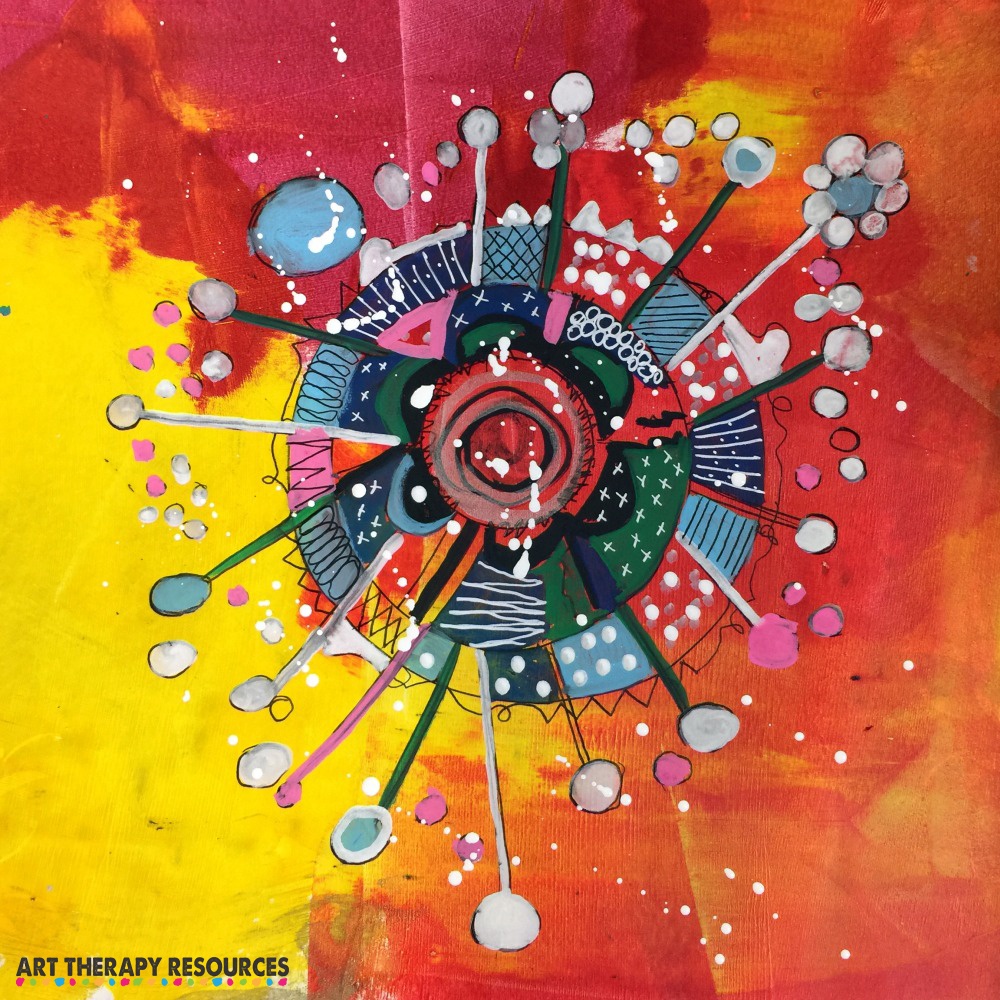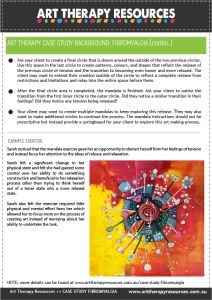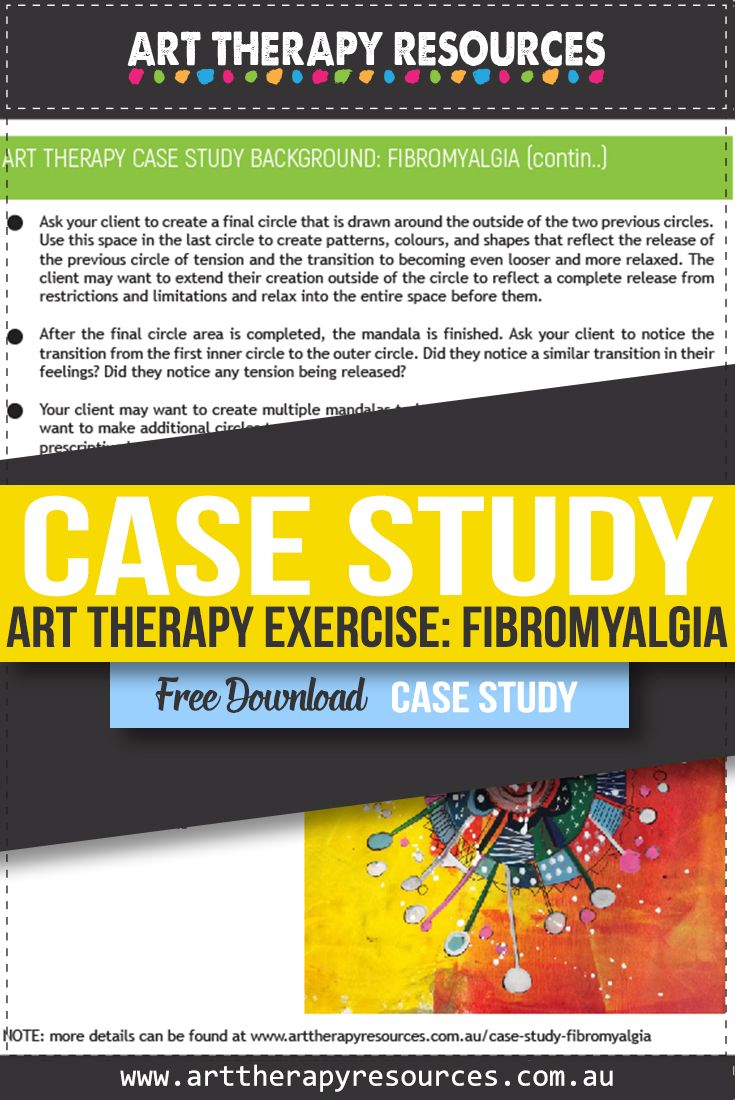THIS POST INCLUDES:
- Art Therapy and Fibromyalgia
- About the Client
- Current Client Issues
- Art Therapy Exercise
- Client Insight and Outcomes
- Disclaimer
- FREE DOWNLOAD Art Therapy Exercise
ART THERAPY AND FIBROMYALGIA
FIBROMYLAGIA DIAGNOSIS
Fibromyalgia is a chronic condition characterised by some common symptoms including:
- Pain throughout the body (often symmetrical)
- Sleep disruption
- Fatigue
- Foggy mental cognition
- Depression
- Issues with perfectionism
- Suppressed emotions (eg. Anger)
As part of the treatment process, many medical professionals focus on pain reduction, improving quality of life, and encouraging patients to engage in functional tasks such as light exercise.
From a psychological point of view, a focus is placed on coping with chronic pain, exploring suppressed emotions such as anger, and dealing with issues of social isolation.
Diagnosing fibromyalgia is often a complex process as the symptoms experienced by individuals with fibromyalgia are often linked to a multitude of short and long term illnesses. It is usually when the symptoms have persisted for a long period of time, that the diagnosis of fibromyalgia becomes the main focus. Unfortunately by this stage, the person with the symptoms has progressed into a chronic stage of pain and uncertainty about their condition. This can have a significant negative effect on mental wellbeing in being able to persist with seeking help and subsequent treatment. Often, at this point, sufferers feel unheard and lack validation of their physical experience.
Check out our previous blog posts on the topic of the connection of mind and body:
Much is still unknown about the pathology of fibromyalgia. Currently, the most common range of symptoms refers to diffuse pain, physical and cognitive fatigue, disturbed sleep and mood disturbances.
HOW ART THERAPY CAN HELP WITH FIBROMYALGIA
The symptoms of fibromyalgia can have a debilitating physical effect, however, it can also have a negative psychological effect. Given the chronic nature of fibromyalgia, the psychological effect can be pervasive and enduring in an individual who has fibromyalgia.
Art therapy can help cope with the psychological experiences of anxiety, anger, depression, frustration, and resentment at feeling physically incapacitated. Art therapy can help explore the intersection of physical pain and psychological perception which can often feel confusing to the individual.
In addition to the psychological impact of chronic pain, chronic illness can isolate you from important social circles. It can also limit your working capacity which can also have an impact on self-esteem, social interactions, and the ability to earn an income for financial stability and independence.
Art therapy can provide a space of free expression for the client who feels constricted and limited by the physical experience within their world. Although this is the case within an art therapy session, it’s important to remember that clients with fibromyalgia can often feel attending art therapy sessions is physically demanding or impossible on any random day. This is important for the art therapist to keep in mind when scheduling sessions with a client diagnosed with fibromyalgia.
While individual client work is an important part of the therapeutic process, group therapy may be useful for a client with fibromyalgia so their attendance is not vital to the therapist helping other clients. Additionally, the client may feel more open to attending art therapy sessions within a group format where they feel their physical symptoms can be accommodated if they are unable to attend.
Check out our previous blog posts on the topic of group art therapy:
Individuals with fibromyalgia will often limit themselves to activities if they foresee the potential of that activity failing due to the experience of pain. Initially, creating a space of open attendance can help further develop stronger belief systems within the client to attend additional sessions.
Check out our previous blog posts on the topic of client barriers to art therapy participation:
One important coping technique involved in coping with fibromyalgia symptoms includes relaxation and release of mental rumination. Art therapy can help facilitate this relaxation and release through various art therapy exercises. One well-known art therapy exercise includes creating mandala’s which focuses on the meditative aspect of creating.
Art therapy uniquely understands the influence of psychological and emotional factors on physical health outcomes. Art therapy can provide a useful way to integrate therapy and physical well-being so that individuals who suffer from fibromyalgia can find ways in which to change their belief systems about their abilities to cope and overcome the effects of chronic pain.
Those who suffer from any chronic pain can appreciate the difficulty in translating the different feelings of physical pain to words. Art therapy can bypass the need for verbal expression and instead connect with the individual’s ability to explain pain through symbolism and visual metaphors. This helps amplify the client’s voice to express and ‘voice’ their personal experience in alternative ways of talking.
FURTHER READING:
Below are links to previous case studies that deal with similar issues experienced by clients diagnosed with fibromyalgia:
- Case Study: Using Art Therapy for a Client who is a Perfectionist
- Case Study: Using Art Therapy for a Client with Anger
- Case Study: Using Art Therapy for a Client with Anxiety (GAD)
- Case Study: Using Art Therapy for a Client with Chronic Illness (Cancer)
- Case Study: Using Art Therapy for a Client with Depression
- Case Study: Using Art Therapy for a Client with Fatigue
ABOUT THE CLIENT
- Name: Sarah
- Age: 58
- Summary of sessions to date: Sarah had attended one art therapy session to date to discuss the impact of fibromyalgia on her lifestyle. Sarah had discussed with her art therapist the desire to learn new coping techniques when her sleep was disrupted at night.
CURRENT CLIENT ISSUES
ART THERAPY EXERCISE
INSTRUCTIONS:
- Explain to your client that this exercise is to help introduce an art exercise focused on relaxation as well as develop a ritual of techniques that can help trigger your client’s cognitive process to work towards relaxation and rest.
- Ask your client to create a space that reflects relaxation and calmness. Remove or reduce any sounds, smells, sights that may be disruptive to the process of relaxing and maintaining focus. Additionally, introduce any calming elements such as soft music, burning essential oils, or a soothing drink that may encourage calm and relaxation.
- Take a series of deep breaths before beginning the art exercise. Let any thoughts that come to mind flow by. Do not focus on any specific thought that enters your mind and do not attempt to resolve any real or perceived problems. Let all thoughts flow through while maintaining a process of deep breathing.
- Ask your client to create a smaller inner circle and use this circle to express the feelings of tension and frustration that may come from not being able to sleep. Include as little or as much detail that expresses this feeling. Use colours and shapes that also reflect this tension.
- After your client has created this circle of pattern, ask them to again engage in deep breathing and the concept of releasing any thoughts as passing through. Do not hold on to any specific thought or attempting to problem solve.
- Ask your client to create a second circle that sounds the first circle. In this circle, ask the client to introduce patterns, colours, and shapes that reflect the release of the first circle of tension. This circle can contain a looser point of view. Maybe some areas are still tense and restricted. If these patterns appear, ask your client to transform them into looser patterns.
- After your client has created this circle of pattern, ask them to again engage in deep breathing and the concept of releasing any thoughts as passing through. Do not hold on to any specific thought or attempting to problem solve.
- Ask your client to create a final circle that is drawn around the outside of the two previous circles. Use this space in the last circle to create patterns, colours, and shapes that reflect the release of the previous circle of tension and the transition to becoming even looser and more relaxed. The client may want to extend their creation outside of the circle to reflect a complete release from restrictions and limitations and relax into the entire space before them.
- After the final circle area is completed, the mandala is finished. Ask your client to notice the transition from the first inner circle to the outer circle. Did they notice a similar transition in their feelings? Did they notice any tension being released?
- Your client may want to create multiple mandalas to keep exploring this release. They may also want to make additional circles to continue the process. The mandala instructions should not be prescriptive but instead, provide a springboard for your client to explore this art making process.
CLIENT INSIGHT AND OUTCOMES
Sarah felt a significant change in her physical state and felt she had gained some control over her ability to do something constructive and beneficial to her relaxation process other than trying to think herself out of a tense state into a more relaxed state. Sarah also felt the exercise required little physical and mental effort from her which allowed her to focus more on the process of creating art instead of worrying about her ability to undertake the task.

DISCLAIMER
This case study represents a snapshot of the client’s progress in treatment. The exercise in this article could be used as written or as a guide for new and original tasks developed by the Art Therapist. Responsibility for treatment resides with the individual therapist who understands their clients specific needs. The art therapy exercise should not be viewed as a pre-defined directive on how to treat a client that presents with a specific range of problems. This art therapy exercise will help build a database of knowledge to draw upon when helping your client. Art Therapy is associated with psychotherapy techniques, however, each therapist often approaches therapy with their own foundation of psychological interventions, whether it be psychotherapy, CBT, DBT or other methods.
FREE DOWNLOAD: Art Therapy Exercise

BUILD YOUR ART THERAPY REFERENCE MATERIALS:
Pin this image to your Pinterest board.

SHARE KNOWLEDGE & PASS IT ON:
If you’ve enjoyed this post, please share it on Facebook, Twitter, Pinterest. Thank you!
